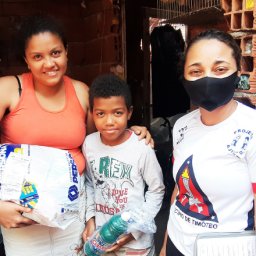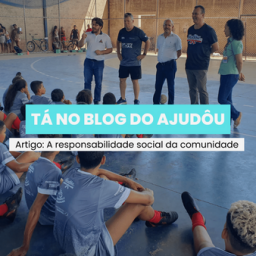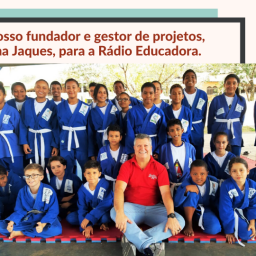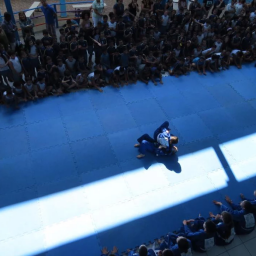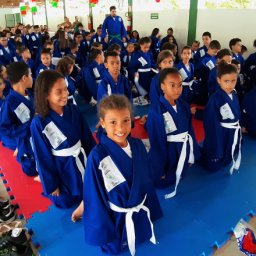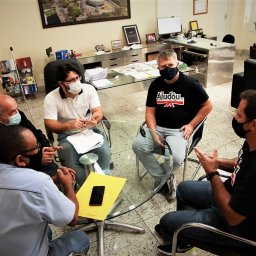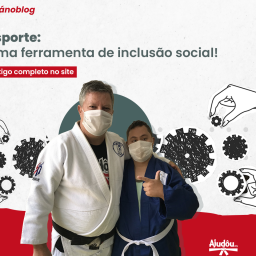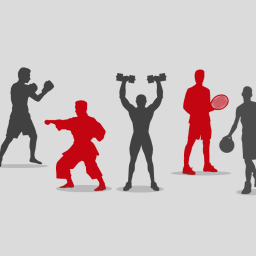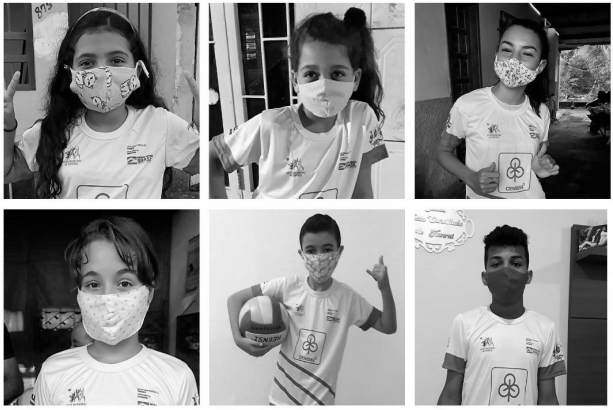
| The information in this manual was taken almost entirely from competent bodies in the fight against Covid-19. Manual on Biosafety for Reopening Schools in the Context of Covid-19Available at: https://portal.fiocruz.br/sites/portal.fiocruz.br/files/documentos/manual_reabertura.pdfProtocol for the Resumption of Sports Activities in the State of São Paulo, considering the Impact of Covid-19 on Sports, Physical Activities and Well-being Available at: https://www.cob.org.br/pt/documentos/download/8412b13a39025 |
Presentation
Public schools are present in several territories, often being the only public policy reference for some communities. Its functions express commitments to human education, science and the defense of life. One of the first measures to reduce the contagion of Covid-19 was the suspension of school activities. In most Brazilian states and municipalities, the suspension took place on March 16, 2020, five days after the World Health Organization (WHO) announced that Covid-19 was a pandemic, with significant mortality. in many countries.
School closures are one of the most evident expressions of the social effects of Covid-19. Data from the United Nations Educational, Scientific and Cultural Organization (Unesco) indicate that this measure reached more than 190 countries, which affected 1.57 billion children and young people – 90% of the student population around the world.
The resumption of school activities in person has been one of the most central discussions on the public agenda during the pandemic, as they are directly linked to the activities of Ajudôu, we will rely on this document produced by Fiocruz on biosafety practices and contingency for the return of children. students to schools.
This manual aims to present how Ajudôu will protect its students during sports classes with new exercise methodologies, hygiene protocols and restrictive measures to avoid contamination of athletes and ONG employees.
1.1 What do we need to know about Covid-19?
On March 11, 2020, the World Health Organization (WHO) declared a pandemic status for Covid-192, that is, it reached worldwide spread, spreading across the different continents of the planet with transmission from person to person.
Covid-19 is a disease caused by infection with the new coronavirus (Sars-CoV-2), presenting a clinical picture that varies from asymptomatic infections to severe respiratory conditions. Its biological variables are, therefore, broad and little known, which makes it difficult to carry out actions and decision-making in advance. As the virus is similar to the one that caused the SARS (severe acute respiratory syndrome) epidemic in 2002, its name included the insertion of the number 2.
This new virus, from the coronavirus family, is known to cause respiratory infections and to have, under a microscope, a crown appearance. It is covered by an envelope that has a lipid (fat) structure and virus proteins. Thus, they can easily lose their infective action with detergents, disinfectants and lipid solvents, and are still sensitive to heat (Flores, 2007).
From the point of view of its origin, Chinese researchers suspect that the new virus originates from bats, as do most other coronaviruses. It is known that there was the phenomenon of ‘zoonotic spillover’, common to most viruses, which caused a coronavirus that affects bats to mutate and go on to infect humans. Research indicates, however, that this mutation was a natural process and not human-induced (Fundação Oswaldo Cruz, 2020a).
1.2 What are the ways in which the virus is transmitted?
As the new coronavirus or Sars-Cov-2 was discovered recently, it is still necessary to develop scientific research to know, in depth, all the characteristics of the behavior of the virus and its manifestations in populations. However, so far, we know that, as the virus is located in the respiratory tract of the infected person, its transmission can occur through the air or from person to person through:
• Droplets produced by infected individuals and which can be transmitted through coughing, sneezing, phlegm or by speaking. These droplets can reach the mouth, eyes or nose of people nearby or can be inhaled into the lungs. They can reach a distance of up to 2 meters in these situations.
• Contact with contaminated objects or surfaces and subsequent contact with the mouth, nose or eyes.
• Physical contact with an infected person, such as by shaking hands with an infected person and then bringing that hand to the mouth, nose or eyes.
The virus can be transmitted not only by people who have signs and symptoms of the disease, but also by all those who have the virus in their body and who have not developed any signs or symptoms of the disease, which we call asymptomatic cases. There are still no scientific studies that can safely state what the percentage of asymptomatic people would be among the total number of infected people.
Knowing the ways in which the virus is transmitted, we know that isolated protection measures will not have consistent effects, but if adopted together, they can reduce its transmissibility. Finally, there is still no knowledge about the durability of the immunity conferred on people who have already had Covid-19, even more so with the new strains. Thus, the procedures described here must be followed by all people who attend the school, including those who have already had the disease.
1.3 What are the signs and symptoms of Covid-19?
Covid-19 can show clinical signs and symptoms that can range from mild to severe. Many of these signs and symptoms have nonspecific characteristics, as they are also evident in other diseases. Others, however, seem to be more specific to Covid-19, such as the loss of smell and taste (1/3 of those infected have it). It should be noted that they can appear in isolation or together, and the manifestation of only a few of them is not uncommon. Symptoms can appear 2 to 14 days after exposure to the virus.
| According to the Centers for Disease Control and Prevention (2020b), the most common symptoms are: • fever (temperature > 37.8°) or chills;• sore throat; • headache; • cough; • fatigue; • loss of taste or smell; • muscle pain; • nausea or vomiting; • shortness of breath or difficulty breathing; • nasal congestion or runny nose; • diarrhea. |
1.4 Procedures in the event of a suspected case of Covid-19 in a student at Ajudôu;
• All workers and students must be informed about the procedures for the identification of a suspected case of Covid-19.
• If any worker or student shows signs or symptoms of Covid-19, the guidance is to stay at home and contact the school to inform the situation.
• Upon identification of a suspected case at school, self-reported or based on the observation of signs and symptoms at the time of entry, it must be referred to the previously defined isolation area and, according to the indications of the protocols of the local health services. , referred to the health service. The ideal procedure is to have an RT-PCR test performed at the health service to confirm the case. The collection of material should be carried out until the eighth day after the onset of signs and symptoms.
• The student’s emergency contacts should be activated for information and guidance on the need for observation and home isolation, also avoiding contact with other residents of the house, especially if they are people at greater risk of developing severe Covid-19. You should also be advised to look for a health facility.
• Strengthen cleaning and disinfection of surfaces most used by the suspected case, including those in the isolation area.
• Guidelines for the collection of waste produced by the suspected case are included in item 2.12.
1.5 Procedures in the face of a confirmed case of Covid-19 in the project carried out by Ajudôu.
Contact the school management to define the methods for tracing contacts in the case and define the parameters for adopting protective measures, such as, for example, the suspension of classes in cases of excessive transmission in the school environment or in the territory.
2. Procedures directly linked to Ajudôu activities in the school territory
2.1 COMMUNICATION AND INFORMATION
• Display information about Covid 19 and prevention measures in a visible place at the entrance of training places;
• Conduct a lecture on care with Covid 19 in the opening class for students and present the protocol for carrying out the training;
• During classes, teachers will always reinforce the prophylaxis measures of Covid 19
2.2 HYGIENIZATION AND DECONTAMINATION
• Make alcohol gel available to practitioners and others present at the training sites;
• Provide liquid soaps and places with running water for hand asepsis;
2.3 INDIVIDUAL PROTECTION MEASURES
• All athletes, practitioners and others present at the training sites must WEAR a MASK, if possible, change the mask every time it is wet;
• Bring your hydration from home, and don’t socialize, or use other people’s containers (squeezes, towels, etc); If you have to use the drinking fountains, avoid taking them directly. First sanitize and then use your glass or bottle to fill with water;
• Frequently wash your hands up to the wrists, with soap and water, or sanitize them with 70% alcohol gel;
• Practice cough etiquette (keep a distance of at least 2 meters, cover your cough and sneeze preferably with your elbow;
• Avoid shaking hands or hugging and touching your own mouth, nose or eyes;
• Use your own equipment. If it is not possible to do so, it is necessary to disinfect the equipment before using it;
• Keep a distance of at least 2 meters from other people, for any training situation;
2.4 COLLECTIVE PROTECTION MEASURES
• Adequacy of the number of students per class according to the size of the space.
• Minimum distance required during classes (1 student per 2m squared).
• All students must start and finish activities in the same amount of time and leave in an orderly manner, without contact and crowding..
• End of classes 10 minutes before to have contact with the class of the next class.
• It is recommended that the practitioner not take backpacks and/or accessories that require care, with the exception of water bottles or squeezes. In modalities where it is necessary to use accessories, these must be in places of access without agglomeration;
• The use and handling of cell phones during physical activity should be avoided;
• Check the temperature of the attendees before entering the training space, not authorizing the entry of people, both athletes and employees, with a temperature of 37.8º or more in the training places;
• Avoid agglomerations before and after training;
• Reinforcement of cleaning of equipment and places for training and circulation of people, especially those for common use, such as mattresses, bars, mattresses, mats and others. At each training session or competition, the place must be disinfected with appropriate products;
• Recommend to risk groups (over 60 years old, heart disease, chronic lung patients, etc.) not to participate in the first weeks of training and competitions;
• Do not use lockers or other places where crowding of people may be encouraged;
• Organize training by appointment and recommend to practitioners that they arrive at the stipulated times, and at the end of the training, do not hold meetings, returning immediately to the residences;
• Physical contact is not allowed in contact sports such as wrestling;


